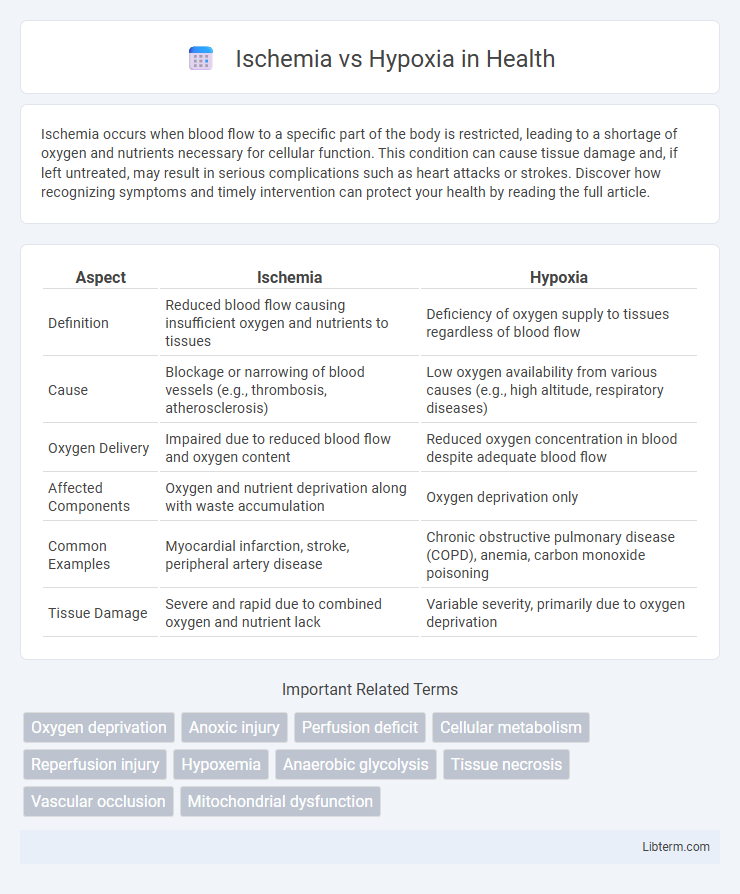Ischemia occurs when blood flow to a specific part of the body is restricted, leading to a shortage of oxygen and nutrients necessary for cellular function. This condition can cause tissue damage and, if left untreated, may result in serious complications such as heart attacks or strokes. Discover how recognizing symptoms and timely intervention can protect your health by reading the full article.
Table of Comparison
| Aspect | Ischemia | Hypoxia |
|---|---|---|
| Definition | Reduced blood flow causing insufficient oxygen and nutrients to tissues | Deficiency of oxygen supply to tissues regardless of blood flow |
| Cause | Blockage or narrowing of blood vessels (e.g., thrombosis, atherosclerosis) | Low oxygen availability from various causes (e.g., high altitude, respiratory diseases) |
| Oxygen Delivery | Impaired due to reduced blood flow and oxygen content | Reduced oxygen concentration in blood despite adequate blood flow |
| Affected Components | Oxygen and nutrient deprivation along with waste accumulation | Oxygen deprivation only |
| Common Examples | Myocardial infarction, stroke, peripheral artery disease | Chronic obstructive pulmonary disease (COPD), anemia, carbon monoxide poisoning |
| Tissue Damage | Severe and rapid due to combined oxygen and nutrient lack | Variable severity, primarily due to oxygen deprivation |
Introduction to Ischemia and Hypoxia
Ischemia refers to the restricted blood flow to tissues, leading to insufficient oxygen and nutrient delivery essential for cellular metabolism. Hypoxia describes a condition where tissues experience a deficiency of oxygen despite adequate blood circulation, impairing cellular functions. Both ischemia and hypoxia disrupt cellular homeostasis, but ischemia additionally limits the removal of metabolic waste, exacerbating tissue injury.
Defining Ischemia
Ischemia refers to the inadequate blood supply to a tissue or organ, leading to a deficiency in oxygen and nutrients essential for cellular metabolism. Unlike hypoxia, which solely indicates a shortage of oxygen at the tissue level, ischemia encompasses both oxygen deprivation and reduced removal of metabolic waste due to impaired blood flow. This condition often results from arterial blockages, thrombosis, or vasoconstriction, leading to tissue damage and potential cell death.
Defining Hypoxia
Hypoxia is defined as a condition in which there is an inadequate supply of oxygen to the tissues, despite normal or sufficient blood flow. It differs from ischemia, where both oxygen and nutrient delivery are impaired due to reduced blood flow. Understanding hypoxia involves recognizing its causes such as respiratory failure, anemia, or high altitude, which affect oxygen availability without necessarily compromising circulation.
Key Differences Between Ischemia and Hypoxia
Ischemia refers to an inadequate blood supply to tissues, causing a shortage of oxygen and nutrients, while hypoxia specifically denotes a deficiency of oxygen in the tissues regardless of blood flow. Ischemia often results in both oxygen deprivation and metabolic waste accumulation, leading to more severe cellular damage than hypoxia alone. Key differences include ischemia's dual impact on oxygen and nutrient delivery versus hypoxia's primary focus on oxygen deficiency.
Causes of Ischemia
Ischemia results from an obstruction or reduction of blood flow to tissues, primarily caused by atherosclerosis, thrombosis, or arterial embolism. Other causes include vasospasm, external compression of blood vessels, and severe hypotension leading to inadequate perfusion. Unlike hypoxia, which is a deficiency in oxygen regardless of blood flow, ischemia specifically involves impaired oxygen and nutrient delivery due to compromised circulation.
Causes of Hypoxia
Hypoxia primarily results from reduced oxygen availability or impaired oxygen utilization in tissues, caused by factors such as low atmospheric oxygen (high altitude), respiratory diseases like chronic obstructive pulmonary disease (COPD), anemia, or circulatory problems limiting oxygen delivery. It can also stem from carbon monoxide poisoning, which impairs oxygen transport by binding to hemoglobin. Unlike ischemia, which involves restricted blood flow, hypoxia can occur with normal circulation but inadequate oxygen supply or utilization.
Clinical Signs and Symptoms
Ischemia presents clinically with localized pain, pallor, and coldness due to inadequate blood supply and oxygen deprivation in tissues. Hypoxia manifests through symptoms such as cyanosis, tachypnea, and altered mental status caused by insufficient oxygen availability in the blood or cells. Differentiating ischemia from hypoxia is critical for diagnosis, with ischemia causing both oxygen and nutrient deficiency, while hypoxia involves oxygen deficiency despite adequate blood flow.
Diagnostic Approaches
Diagnostic approaches for ischemia primarily involve imaging techniques such as angiography, which visualizes blood vessel blockages, and Doppler ultrasound that assesses blood flow abnormalities. Hypoxia diagnosis relies on pulse oximetry to measure oxygen saturation in the blood and arterial blood gas (ABG) analysis to evaluate oxygen and carbon dioxide levels at the tissue level. Both conditions benefit from advanced modalities like MRI and CT scans to detect tissue damage and differentiate ischemic injury from hypoxic effects based on perfusion and oxygenation patterns.
Treatment and Management Strategies
Treatment and management of ischemia focus on restoring blood flow to the affected tissues through interventions such as thrombolytic therapy, angioplasty, or surgical bypass, along with anticoagulants and antiplatelet agents to prevent clot formation. Hypoxia management involves optimizing oxygen delivery by administering supplemental oxygen, improving ventilation, and addressing underlying causes such as anemia, respiratory disorders, or carbon monoxide poisoning. Both conditions require continuous monitoring of tissue perfusion and oxygenation, with supportive care tailored to the severity and etiology of the oxygen deprivation.
Prognosis and Complications
Ischemia, characterized by restricted blood flow leading to oxygen and nutrient deprivation, often results in more severe tissue damage and worse prognosis compared to hypoxia, which is a deficiency of oxygen without impaired blood flow. Complications of ischemia include infarction, necrosis, and organ dysfunction, whereas hypoxia may cause cellular injury and reversible tissue damage if oxygen supply is restored promptly. Early intervention improves outcomes in both conditions, but prolonged ischemia leads to irreversible damage and higher morbidity and mortality rates.
Ischemia Infographic

 libterm.com
libterm.com